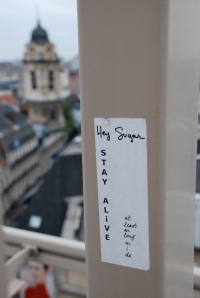That three-letter word can be a real irk. If there is ever a competition held on art, it would most probably be one of the very few fields that we would unlikely win. The vagueness and endless possibilities of art as an idea are, fortunately (and unfortunately), downright simple. The possibilities of the said vague idea is endless.
This Is A Review: Art
June 13, 2011Unproductive cattle prodding
June 2, 2011This Om’bak post is in response to a number of status updates that have been popping up in my Facebook feed and on Twitter after the Four Corners program “A Bloody Business” about the mistreatment of cattle in Indonesia and Australia’s complicity in this mistreatment.
For those reading about this for the first time, The Economist has a pretty good overview of what has been the reaction in Australia after the program aired on Monday.
Of sacred spaces and super powers
August 15, 2010Anyone seen “The Last Airbender” yet?
It’s cute. I mean if this was meant to be a movie review I’d ramble on about squeezed-in plots, less than satisfactory acting, and weird choice of cast, but perhaps not many people would be interested in reading something like that from someone whose favorites include “White Chicks.”
Nevertheless, aside from the gorgeous temples and lovely dining sets, one line stuck to my head:
A’ang (the kid hero): “Is there any sacred places here? I need to reach the spirits”
(well, kind of..that’s roughly what he said anyway)
It was crucial moment. He had to ask for advice from the wise dragon spirit about how to beat gazillions of war ships from the Fire Nation, who were trying to take over a kingdom inhabited by the people of the Northern Water Tribe.
Couldn’t he just close his eyes and tell that spirit to hurry up and give some goddamn clues before the place gets burned down?
There are several reasons. First of all, he’s still a kid with limited experience chatting with spirits. Second, he had his first encounter with the dragon when he was in his own temple, which, of course, has deep spiritual significance to him.
Thus he had to go to the Water Tribe’s sacred spot, where a cherry blossom tree flowers perennially above a tranquil pool in which two fish – the yin and the yang -swim about.
It was in the middle of a war and he had to meditate. Was it worth it? Well, I won’t say who won, but it was.
Now let’s teleport back to a world without giant, furry, flying creatures and the widespread ability to bend elements.
When I went to Victoria a few weeks ago, I realized how lucky Muslims in Indonesia are.
No one questions why you get up from your desk at least twice a day to wash your hands and feet and put on special garments just to remember your creator. Praying spaces are virtually everywhere: malls, train stations, even in close proximity to bars and clubs.
Most of these places also provide praying garments for women.
When I went to a mosque in Carlton, I found no women inside, let alone any garments for me to borrow.
Here’s an interesting insight on Australian Muslims. The first paragraph kind of sums it up.
So yeah, its a pain, despite Melbourne’s (the state’s capital) reputation for being one of the most culturally diverse cities.
The headline in today’s The Jakarta Post read: “Attack on church sparks widespread outrage”
On Sunday, a group called the Islamic Community Forum attacked a church group in Bekasi, West Java. Around 20 people were hurt in one of the many church attacks the country has seen these recent months.
Next, the headline on today’s International Herald Tribune: “Protests erupt in the U.S over proposed mosques”.
Some people are not impressed by the idea of building a mosque near New York’s ground zero, and apparently this is just one of the many planned mosques to be met with hostility across the land of the free.
How important is a place of worship? Some might say God is everywhere and you can just close your eyes in a bus to remember the Creator-Destroyer.
But some just need a special place where they feel at home. Not only for individual solitude, mosques and other religious buildings can serve as community meeting places, for discussion and celebration. Hatred preaching? Maybe.
But isn’t a place of prayer supposed to be, first and foremost, a place where one can be at peace?
You know, even a wonder boy needs that place just to get in the mood.
Right now, some churchgoers in Greater Jakarta are on the point of exasperation because although they feel that they have fulfilled the necessary paperworks (ask for consent from locals, ask for land permits, etc), getting a church up seemed more and more of a wishful thinking, not to mention constant protests they have to face during services.
Meanwhile, in Tenecula, U.S, people who are against a center for Islam communities are deliberately bringing dogs in rallies to protest the plan, knowing that dogs are often considered unclean by Muslims.
We might not all be praying to save a land from invaders, but is it too much to ask for a little space?
There’s something about stories
June 8, 2010I don’t know about you, but I like fairy tales. I still do. Even after all these years. And no, not just because of the pretty, pretty dresses worn by the princes and the princesses, the grandiose castles—almost always looking as if they needed redecorating—or the heavenly creatures that roam the vast land endlessly.
And they make quite a bedtime story, too.
When it was still the ‘80s or the ‘90s, it was not too difficult to find “real” bedtime stories. There was that Sanggar Cerita cassette series in its thick, bulgy, white plastic casings that set it apart from other tapes. An older version of the series also came with the ordinary see-through plastic cassette casings used for the packaging of music albums and are, apparently, less likely to swell oversize to the brink of no clicking upon closing like the white plastic ones in the heat.
Another thing is that the bedtime stories didn’t usually come with a transcript of the story, and this sometimes (and only sometimes) has made it a witty bit frustrating for the curious sleepyheads who didn’t quite catch the difficult words inside the tale. There were quite a few “Apa?” instead of the glorious A-ha moments, as a result to that.
The collection includes an assortment of stories with a lineup of bizarre, if not freaky, characters. There was Si Kancil, a tiny deer in his attempts to find juicy, tasty cucumbers to legendary characters that are either turned to national treasures (Malinkundang was turned to stone), forced to marry (Siti Nurbaya) or just plain legendary, like the want-it-all Roro Jongrang.
These and other given characters with names the like of Putri Angsa Putih, Putri Kecapi, superhero names (there was one, at least, that included Superman’s kicks) and even pets, like Ular Sang Pangeran, have helped children all over the country get some quality sleep. These characters are usually flaunted on the two-fold cassette covers that looked really dandy, as if they were hand painted, each and every one of them, for that specific story.
Each side of the tape contains, usually, one story for the A-side and another one for the B-side. When you’re lucky, however, you’ll find a story that continues to the other side. When that happens, regardless of having made to endure the opening jingle twice, it sure feels more than good.
But that was before the illustrated children’s story books came along, before being “properly” introduced to Rapunzel, the Tweedle brothers from “Alice in Wonderland” or Jiminy the cricket. And before I realized that when you leave the tapes in the open and don’t play them quite often, they’re bound to grow fungus. And when that happens you just need to be kind, and rewind.
And now for a bit of revisionism
May 15, 2010After months of living in Amsterdam, avoiding the tourist traps, I finally went to the Rijksmuseum, the national museum of the Netherlands. Among the marble busts of war heros and large paintings of Dutch colonial ships, I spent a lot of time staring at paintings of Batavia.

Pieter Cnoll, senior merchant of Batavia, his wife and their daughters.
A Drunken Kartini Day With the Boys
April 23, 2010I was kicking myself last month when I realised that International Women’s Day had crept up on me and that I had no time to prepare a celebratory night out, or at least a rant of some sort to have published.
And the same thing happened to me on Tuesday night. “Do you know it’s Kartini Day tomorrow?” my housemate asked me.
For those of you who don’t know, the late Raden Ajeng Kartini in 1903 established Indonesia’s first primary school for girls that offered an education regardless of social status, and she is still today Indonesia’s most-celebrated feminist.
To honour this pioneer, a little establishment down the road from my place put on an event to raise money to buy books for kids. The idea was to have 21 women behind the bar pouring drinks, as the day is celebrated on April 21, Kartini’s birthday.
But as my housemate and I stepped into the bar, we realised that these ad hoc bartenders were not just ordinary women. These were particularly attractive women, many of whom, we later found out, were professional models and socialites.
The breakdancer letter
March 15, 2010Good evening lover,
I went home at around 10 tonight. The grouch that is our dear friend dropped me off in front of your former nest on his way for drinks.
The rain had been reduced to a faint drizzle, and I hopped on the first bus in line – a big, newish, green one.
The first entertainer on board was a guy with a slightly out-of-tune guitar singing Indonesian ballads. I’ve seen a fair amount of that so I concentrated on reading the book with the lonesome fireworks artisan character who shared your name.
Then a few pages away from the end I was distracted by a distinctively early 90s hip-hop tune and looked up to see a man in his late 20s perhaps, carrying a stereo and breakdancing to the song.
Returned to Oz
January 10, 2010Everyone keeps saying, in strong Australian twangs, “You’ve come full circle”. And I suppose I have, ending in the very same place I left a year and ten months ago. After a year working in Indonesia and travel stints in Canada and South America, with dread and an empty bank account I returned to my hometown.
I was scared that I had changed and more that I hadn’t. I was terrified of Australia and Australians and, in particular, the accent. And so I hid from the quaint, beachside town. I hid from my friends and telecommunication. Locked in a weatherboard house, I dreamt of other places.
But eventually cultural cringe subsided and I finally left the house. I became romantic and wistful, and I began to love this sun-drenched country once again.
While I thought I would be soon moving on, I stumbled upon employment at a local newspaper. And in an instant my trajectory changed. No more suitcases. No more backpacks. No more coming and no more going. In 2010, I am staying put, under clear skies and amid gumtrees, with sand forever in my bed.
At least as long as I do
January 7, 2010
Last week I moved, again. I packed up 40 kilograms of possessions, divided them in two piles: Those needed for backpacking in Spain, those I’d take with me to my next fixed address in Amsterdam.
I was clearing up scraps of paper, train tickets and other bits of rubbish I always attach excessive sentimentality to. In place of people that can’t be brought along. I put on Cold Chisel because I needed a rock that afternoon. Soundtrack to a teenagehood driving on open roads for hours, where you never really moved from the one place. My Australian childhood. Working out exactly what that is requires comparative study.
Hej Hej Denmark. Hola Spain: go easy on me. Only credibility I’ve got is a pure bloodline and a surname as common as pan (that´s bread in the language I am far more comfortable with). Wondering if Spain will be one of my anchor points, or if this is just a pilgrimage of obligation. Often try to work out which countries will make the cut in the long run, which ones will just blur in nostalgic appreciation for the travel calling. Yesterday I changed direction walking and tracked a man in the street for a few minutes because he was speaking Indonesian on his mobile.
It’s New Years but I’m not making any new resolutions. Are you finally getting old when the anniversaries roll around, and you realize that to get things done, you’re just going to have to work at it everyday? Some mornings I forget that, others I get myself back on track. When I was little I didn’t even know you had to make that kind of an effort once you’d grown up.
In transition, on a mission
January 6, 2010I started 2009 cutting my hair really short. I’m leaving it to grow as I leave it. I have a mission. I’m in transition.
In 2009, I loved, I hid, I pretended, I lost, I told the truth, I hurt, I forgive, I made friends, I got inspired, I struggled, I worked hard, I learn.
I am now in waiting, which makes me nervous. Future possibilities fill my heart with excitement. But the thought of failure scares me and puts me down in seconds. Jakarta is like a demanding lover that you love and hate simultaneously. Or at least, that is how I feel.
If things don’t go as planned. I will view my life like in Greek tragic art. It’s easier to endure failure if you can blame it on superhuman gods. After that, I will try again.

